Applied Mathematics
Vol. 3 No. 7 (2012) , Article ID: 20013 , 4 pages DOI:10.4236/am.2012.37120
A Note on Directed 5-Cycles in Digraphs*
1Department of Mathematics, Southwestern University of Finance and Economics, Chengdu, China
2School of Mathematical Sciences, University of Science and Technology of China, Wentsun Wu Key Laboratory of CAS, Hefei, China
Email: #lianghao@mail.ustc.edu.cn
Received May 18, 2012; revised June 18, 2012; accepted June 25, 2012
Keywords: Digraph; Directed Cycle
ABSTRACT
In this note, it is proved that if , then any digraph on n vertices with minimum outdegree at least
, then any digraph on n vertices with minimum outdegree at least  contains a directed cycle of length at most 5.
contains a directed cycle of length at most 5.
1. Introduction
Let  be a digragh without loops or parallel edges, where
be a digragh without loops or parallel edges, where  is the vertex-set and
is the vertex-set and  is the arc-set. In 1978, Caccetta and Häggkvist [1] made the following conjecture:
is the arc-set. In 1978, Caccetta and Häggkvist [1] made the following conjecture:
Conjecture 1.1 Any digraph on n vertices with minimum outdegree at least r contains a directed cycle of length at most .
.
Trivially, this conjecture is true for , and it has been proved for
, and it has been proved for  by Caccetta and Häggkvist [1],
by Caccetta and Häggkvist [1],  by Hamildoune [2],
by Hamildoune [2],  and
and  by Hoáng and Reed [3],
by Hoáng and Reed [3],  by Shen [4]. While the general conjecture is still open, some weaker statements have been obtained. A summary of results and problems related to the Caccetta-Häggkvist conjecture sees Sullivan [5].
by Shen [4]. While the general conjecture is still open, some weaker statements have been obtained. A summary of results and problems related to the Caccetta-Häggkvist conjecture sees Sullivan [5].
For the conjecture, the case  is trivial, the case
is trivial, the case  has received much attention, but this special case is still open. To prove the conjecture, one may seek as small a constant
has received much attention, but this special case is still open. To prove the conjecture, one may seek as small a constant  as possible such that any digraph on n vertices with minimum outdegree at least
as possible such that any digraph on n vertices with minimum outdegree at least  contains a directed triangle. The conjecture is that
contains a directed triangle. The conjecture is that . Caccetta and Häggkvist [1] obtained
. Caccetta and Häggkvist [1] obtained
 , Bondy [6] showed
, Bondy [6] showed  , Shen [7] gave
, Shen [7] gave
 , Hamburger, Haxell, and Kostochka [8] improved it to 0.35312. Hladký, Král’ and Norin [9] further improved this bound to 0.3465. Namely, any digraph on n vertices with minimum out-degree at least 0.3465n contains a directed triangle. Very recently, Lichiardopol [10] showed that for
, Hamburger, Haxell, and Kostochka [8] improved it to 0.35312. Hladký, Král’ and Norin [9] further improved this bound to 0.3465. Namely, any digraph on n vertices with minimum out-degree at least 0.3465n contains a directed triangle. Very recently, Lichiardopol [10] showed that for , any digraph on n vertices with both minimum out-degree and minimum in-degree at least
, any digraph on n vertices with both minimum out-degree and minimum in-degree at least  contains a cycle of length at most 3.
contains a cycle of length at most 3.
In this note, we consider the minimum constant  such that any digraph on n vertices with minimum outdegree at least
such that any digraph on n vertices with minimum outdegree at least  contains a directed cycle of length at most 5. The conjecture is that
contains a directed cycle of length at most 5. The conjecture is that . By refining the combinatorial techniques in [6,7,11], we prove the following result.
. By refining the combinatorial techniques in [6,7,11], we prove the following result.
Theorem 1.2 If , then any digraph on n vertices with minimum outdegree at least
, then any digraph on n vertices with minimum outdegree at least  contains a directed cycle of length at most 5.
contains a directed cycle of length at most 5.
2. Proof of Theorem 1.2
We prove Theorem 1.2 by induction on n. The theorem holds for  clearly. Now assume that the theorem holds for all digraphs with fewer than n vertices for
clearly. Now assume that the theorem holds for all digraphs with fewer than n vertices for . Let G be a digraph on n vertices with minimum outdegree at least
. Let G be a digraph on n vertices with minimum outdegree at least . Suppose G contains no directed cycles with length at most 5. We can, without loss of generality, suppose that G is r-outregular, where
. Suppose G contains no directed cycles with length at most 5. We can, without loss of generality, suppose that G is r-outregular, where , that is, every vertex is of the outdegree r in G. We will try to deduce a contradiction. First we present some notations following [7].
, that is, every vertex is of the outdegree r in G. We will try to deduce a contradiction. First we present some notations following [7].
For any , let
, let  and
and , the outdegree of
, the outdegree of ;
;
 and
and , the indegree of
, the indegree of .
.
We say  a transitive triangle if
a transitive triangle if  . The arc
. The arc  is called the base of the transitive triangle.
is called the base of the transitive triangle.
For any , let
, let  and
and , the number of induced 2-path with the first arc
, the number of induced 2-path with the first arc ;
;
 and
and , the number of induced 2-path with the last arc
, the number of induced 2-path with the last arc ;
;
 and
and , the number of transitive triangles with base
, the number of transitive triangles with base .
.
Lemma 2.1 For any ,
,
 (1)
(1)
Proof: To prove this inequality, we consider two cases according to  or
or .
.
If , then substituting it into (1) yields
, then substituting it into (1) yields
 (2)
(2)
There exists some  with outdegree less than
with outdegree less than  in the subdigraph of G induced by
in the subdigraph of G induced by  (Otherwise, this subdigraph would contain a directed 4-cycle by the induction hypothesis). Thus
(Otherwise, this subdigraph would contain a directed 4-cycle by the induction hypothesis). Thus
 .
.
Consider the subdigraph of G induced by , by the induction hypothesis, some vertex
, by the induction hypothesis, some vertex  has outdegree less than
has outdegree less than  in this subdigraph. Thus, the set of outneighbors of x not in
in this subdigraph. Thus, the set of outneighbors of x not in  satisfies
satisfies

Since  has no directed 5-cycle, then
has no directed 5-cycle, then ,
,  ,
,  ,
,  and
and  are pairwise-disjoint sets with cardinalities r,
are pairwise-disjoint sets with cardinalities r,  ,
,
 ,
,  and
and , we have that
, we have that
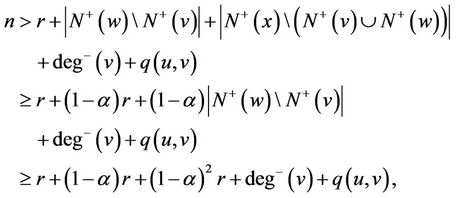
Thus, the inequality (1) holds for .
.
We now assume . By the induction hypothesis, there is some vertex
. By the induction hypothesis, there is some vertex  that has outdegree less than
that has outdegree less than  in the subdigraph of G induced by
in the subdigraph of G induced by , otherwise, this subdigraph would contain a directed 5-cycle. Also, w has not more than
, otherwise, this subdigraph would contain a directed 5-cycle. Also, w has not more than  outneighbors in the subdigraph of G induced by
outneighbors in the subdigraph of G induced by . Let
. Let  be the outneighbors of w which is not in
be the outneighbors of w which is not in . Noting that
. Noting that , we have that
, we have that
 (3)
(3)
Because G has no directed triangle, all outneighbors of w are neither in  nor in
nor in . Consider the subdigraph of G induced by
. Consider the subdigraph of G induced by , by the induction hypothesis, there is some vertex
, by the induction hypothesis, there is some vertex 
 that has outdegree less than
that has outdegree less than  in this subdigraph. Thus, the set of outneighbors of x not in
in this subdigraph. Thus, the set of outneighbors of x not in  satisfies
satisfies
 (4)
(4)
Since G has no directed 4-cycle, all outneighbors of w are neither in  nor in
nor in . Consider the subdigraph of G induced by
. Consider the subdigraph of G induced by  by the induction hypothesis, there is some vertex
by the induction hypothesis, there is some vertex

that has outdegree less than

in this subdigraph. Thus, the set of outneighbors of y not in  satisfies
satisfies
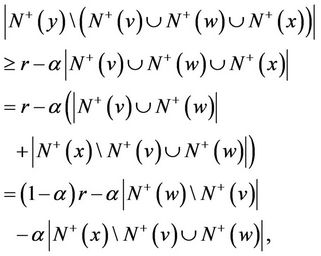 (5)
(5)
Because G has no directed cycle of length at most 5, then ,
,  ,
,
 ,
,
 ,
,
 and
and  are pairwise-disjoint sets of cardinalities r,
are pairwise-disjoint sets of cardinalities r,  ,
,
 ,
,
 ,
,
 and
and , we have that
, we have that
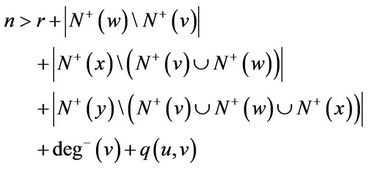
Substituting (3), (4) and (5) into this inequalities yields
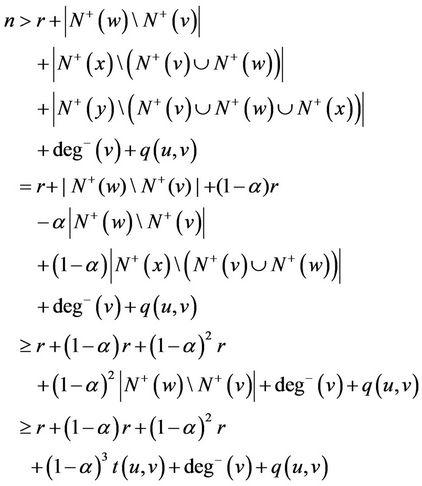
as desired, and so the lemma follows.
Connect to Proof of Theorem 1.2
Recalling that , we can rewrite the inequality (1) as
, we can rewrite the inequality (1) as
 (6)
(6)
Summing over all , we have that
, we have that
 (7)
(7)
where t is the number of transitive triangles in G, and
 (8)
(8)
By Cauchy’s inequality and the first theorem on graph theory (see, for example, Theorem 1.1 in [12]), we have that
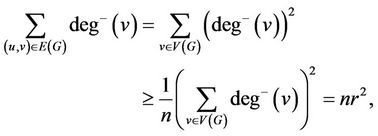
that is
 (9)
(9)
Because  and
and  are both equal to the number of induced directed 2-paths in G, it follows that
are both equal to the number of induced directed 2-paths in G, it follows that
 (10)
(10)
Summing over all  for the inequality (6) and substituting inequalities (7)-(10) into that inequality yields,
for the inequality (6) and substituting inequalities (7)-(10) into that inequality yields,
 (11)
(11)
Noting that  (see Shen [7]), we have that
(see Shen [7]), we have that
 (12)
(12)
Combining (11) with (12) yields
 (13)
(13)
Dividing both sides of the inequality (13) by and noting that
and noting that , we get
, we get

that is

We obtain that , a contradiction. This completes the proof of the theorem.
, a contradiction. This completes the proof of the theorem.
REFERENCES
- L. Caccetta and R. Häggkvist, “On Minimal Digraphs with Given Girth,” Proceedings of the 9th Southeast Conference on Combinatorics, Graph Theory, and Computing, Boca Raton, 1978, pp. 181-187.
- Y. O. Hamidoune, “A Note on Minimal Directed Graphs with Given Girth,” Journal of Combinatorial Theory, Series B, Vol. 43, No. 3, 1987, pp. 343-348.
- C. Hoáng and B. Reed, “A Note on Short Cycles in Digraphs,” Discrete Mathematics, Vol. 66, No. 1-2, 1987, pp. 103-107. doi:10.1016/0012-365X(87)90122-1
- J. Shen, “On the Girth of Digraphs,” Discrete Mathematics, Vol. 211, No. 1-3, 2000, pp. 167-181. doi:10.1016/S0012-365X(99)00323-4
- B. D. Sullivan, “A Summary of Results and Problems Related to the Caccetta-Häggkvist Conjecture,” 2006. http://www.aimath.org/WWN/caccetta/caccetta.pdf
- J. A. Bondy, “Counting Subgraphs: A New Approach to the Caccetta-Häggkvist Conjecture,” Discrete Mathematics, Vol. 165-166, 1997, pp. 71-80. doi:10.1016/S0012-365X(96)00162-8
- J. Shen, “Directed Triangles in Digraphs,” Journal of Combinatorial Theory, Series B, Vol. 74, 1998, pp. 405- 407.
- P. Hamburger, P. Haxell and A. Kostochka, “On the Directed Triangles in Digraphs,” Electronic Journal of Combinatorics, Vol. 14, No. 19, 2007.
- J. Hladký, D. Král’ and S. Norin, “Counting Flags in Triangle-Free Digraphs,” Electronic Notes in Discrete Mathematics, Vol. 34, 2009, pp. 621-625. doi:10.1016/j.endm.2009.07.105
- N. Lichiardopol, “A New Bound for a Particular Case of the Caccetta-Häggkvist Conjecture,” Discrete Mathematics, Vol. 310, No. 23, 2010, pp. 3368-3372. doi:10.1016/j.disc.2010.07.026
- Q. Li and R. A. Brualdi, “On Minimal Regular Digraphs with Girth 4,” Czechoslovak Mathematical Journal, Vol. 33, 1983, pp. 439-447.
- J.-M. Xu, “Theory and Application of Graphs,” Kluwer Academic Publishers, Dordrecht/Boston/London, 2003.
NOTES
*Supported by NNSF of China (No. 11071233).
#Corresponding author.

